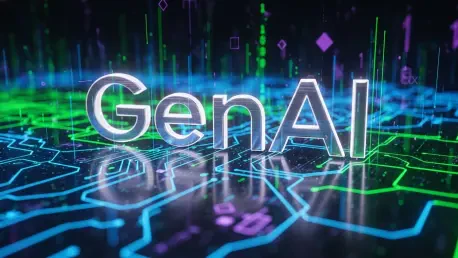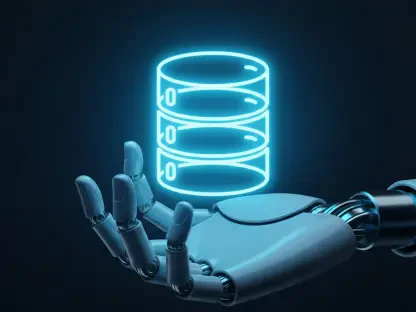In a world where generative AI (GenAI) powers everything from content creation to customer service, a staggering statistic grabs attention: nearly 40% of U.S. adults aged 18-64 now rely on GenAI tools, with 24% of workers using them weekly, according to a National Bureau of Economic Research survey. This explosive adoption raises a critical question: are the systems behind these technologies built to handle such unprecedented demand? The architecture of GenAI platforms is no longer just a technical detail—it’s a deciding factor in whether innovation thrives or stalls. This exploration dives into the heart of microservices, a design approach promising flexibility, but at what cost?
Why Architecture Matters in the GenAI Surge
The rise of GenAI has turned industries upside down, demanding systems that can scale rapidly and adapt to constant change. Traditional monolithic architectures, where all components are tightly integrated into a single unit, often buckle under the pressure of massive datasets and fluctuating user loads. Microservices, by contrast, break applications into smaller, independent pieces, each handling a specific task like data processing or model inference. This shift isn’t just a trend—it’s a response to the urgent need for agility in a tech landscape where delays can mean losing ground to competitors.
The stakes couldn’t be higher. With businesses racing to integrate GenAI into their operations, a poorly chosen architecture can lead to costly downtime or sluggish updates. Microservices offer a potential lifeline, but the decision to adopt them isn’t straightforward. It’s a balancing act between immediate needs and long-term goals, forcing tech leaders to rethink how systems are built from the ground up.
Unpacking the Power of Microservices in GenAI
At their core, microservices enable a modular approach, allowing teams to update or scale specific parts of a GenAI system without touching the rest. This is a game-changer for platforms requiring frequent model refreshes—think real-time analytics tools that must adapt to new data patterns overnight. Selective scaling means resources are allocated only where needed, cutting waste and boosting efficiency, while fault isolation ensures a glitch in one service doesn’t crash the entire system.
Yet, the allure of modularity comes with strings attached. Experts note that the distributed nature of microservices can introduce latency, slowing down processes that GenAI often needs to execute in milliseconds. The resilience gained from isolating failures is real, but so is the challenge of managing a sprawling network of services, each with its own dependencies. This duality makes microservices a powerful yet demanding choice for GenAI deployments.
The Hidden Costs and Complexities
The operational overhead of microservices is a hurdle many teams underestimate. Orchestrating multiple services requires sophisticated tools for containerization, monitoring, and secure communication—investments that can strain budgets, especially for smaller organizations. Beyond financial costs, there’s a steep learning curve; teams must master distributed tracing and debugging across fragmented systems, a far cry from the simplicity of a monolithic setup.
Latency isn’t the only technical snag. As services communicate over networks, new failure points emerge, complicating efforts to maintain seamless performance. Industry leaders caution that without a clear justification—like a need for rapid, independent updates—the complexity of microservices can outweigh their benefits. For GenAI projects with stable workloads, sticking to a simpler architecture might be the smarter play.
Real Stories from the GenAI Frontlines
Insights from the field paint a vivid picture of microservices in action. A tech director at a leading AI firm shared how their team used microservices to overhaul a GenAI-powered chatbot, enabling daily updates to language models without disrupting user interactions. “The ability to tweak one component while the rest runs smoothly saved us weeks of downtime,” they noted. This agility proved invaluable in staying ahead of user expectations.
On the flip side, not every story is a success. A startup focusing on GenAI for content generation found itself bogged down by the intricacies of managing a microservices setup. “The tools and skills needed were beyond our reach early on,” admitted a project lead, highlighting how the architecture overwhelmed their limited resources. These contrasting experiences underscore that microservices aren’t a universal fix—they thrive only in the right context.
Strategies for Tackling the Microservices Challenge
For organizations eyeing microservices in GenAI, a pragmatic approach is essential. Start by evaluating project demands: if frequent updates or massive scalability are non-negotiable, microservices might be worth the investment. But for early-stage or stable applications, beginning with a monolithic design and transitioning later as complexity grows can save headaches. Assessing team readiness for tools like Kubernetes or distributed monitoring is also critical before diving in.
Balancing cost against benefit requires a tailored strategy. Hybrid architectures, blending monolithic cores with microservices for high-demand areas, offer a middle ground for teams hesitant to fully commit. Regularly revisiting architectural choices ensures alignment with evolving goals, preventing costly overhauls down the line. These steps provide a roadmap for navigating the maze of microservices without losing sight of practical outcomes.
Reflecting on the Path Forward
Looking back, the journey through the world of microservices in GenAI reveals a landscape of immense potential tempered by significant hurdles. The stories of triumph and struggle shared by industry players paint a clear lesson: success hinges on matching architecture to specific needs. Every decision carries weight, shaping how swiftly innovation can unfold or how deeply resources are stretched.
As teams move forward, the focus shifts to deliberate planning—evaluating whether the flexibility of microservices justifies their demands or if simpler solutions suffice. The next steps involve fostering skills, experimenting with hybrid models, and keeping an eye on emerging tools that could ease the burden of distributed systems. In this ever-evolving field, staying adaptable remains the key to turning architectural challenges into stepping stones for progress.









